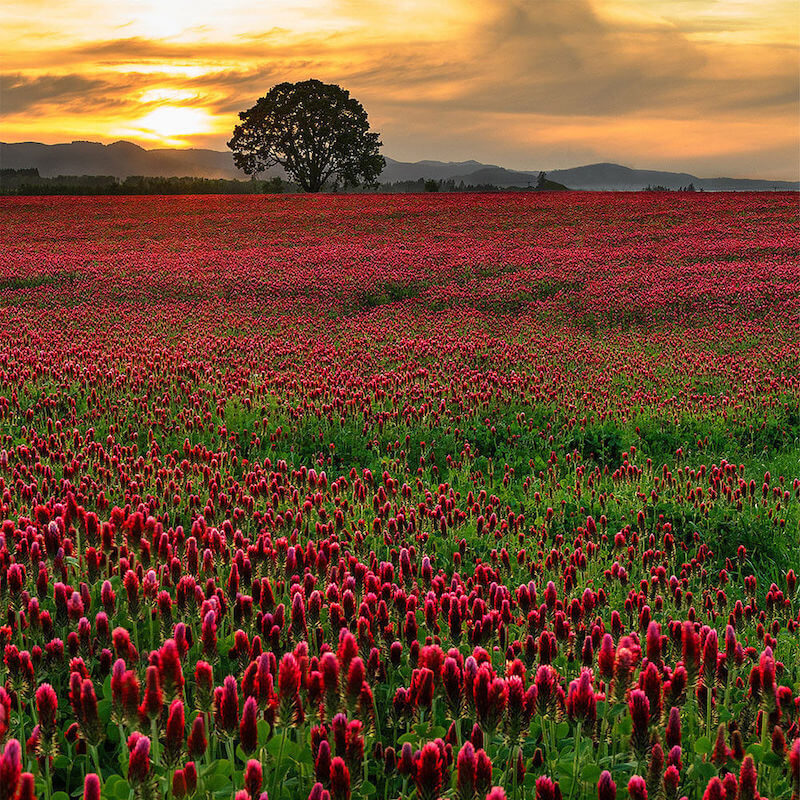
Crimson clover (Trifolium incarnatum) is a popular annual legume that is native to the Mediterranean region. Clover is actually a pea plant used as a cover crop or as a forage crop in agricultural systems.
Crimson clover is herbaceous, growing 1 or 2 feet tall with a fibrous root system. The leaves are trifoliate, meaning they have three leaflets that are ovate or elliptical in shape and have a v-shaped white marking. The flowers are bright crimson in color and are clustered together in a cylindrical inflorescence called a spike. The fruit of the plant is a small pod that contains seeds.
Crimson clover thrives in a variety of soils but grows best in well-draining loamy soil with a pH between 6.0 and 7.5. The plant is adapted to cool and moist climates and can tolerate temperatures as low as 10°F. Crimson clover is an annual plant, which means it completes its life cycle in one growing season. It is often sown in the fall or early spring for a summer or winter harvest.
Crimson clover is a popular cover crop because it can improve soil health and productivity. As a legume, it has the ability to fix nitrogen from the air and store it in nodules on its roots, which can be used to feed other plants. A freshly turned clover crop has proven to increase yields and reduce fertilizer costs. In addition, crimson clover can improve soil structure, increase water infiltration, and reduce erosion.
Crimson clover is also a beneficial plant to improve subterranean biodiversity. Its deep root system can provide habitat for earthworms and other soil organisms, which can improve soil fertility and nutrient cycling. Clover also provides nectar and pollen for hummingbird, bee, butterfly, and dragonfly pollinators.

Clover, both as a ground cover and a fodder plant, has several uses. Firstly, it significantly enhances soil fertility by fixing atmospheric nitrogen, benefiting subsequent crops that are grown in the same soil. It's a cost-effective alternative to expensive synthetic fertilizers. Secondly, it's an excellent choice for animal feed, ideal for land grazing or dried and stored as a food source for the winter months. It is also an important plant for the production of honey.
Crimson clover is an excellent source of animal feed for livestock. It is high in protein and rich in vitamins and minerals, which improve the health and productivity of animals. There are several ways to use crimson clover as animal feed, including grazing live plants in the field, cutting, and drying the plants, and composting the plant material as an off-site organic soil additive.
One way to use crimson clover as animal feed is to allow livestock to graze on live plants in the field. This can provide a natural and nutritious food source for animals, as well as help to maintain the health of the crimson clover plants. Grazing live plants in the field can also reduce the labor and cost associated with harvesting and storing dried plant material.
Another way to use crimson clover as animal feed is to cut and dry the plants in the sun. Once dry, they can be stored and used as needed. Dried crimson clover can be fed to livestock in several ways, including as hay, silage, or as a supplement to other feed sources.
Composting the plant material from crimson clover is another way to use it as an off-site organic soil additive. Composting can help to break down the plant material and create a nutrient-rich soil amendment that can improve soil fertility and structure. The compost can be applied to fields or gardens to enhance plant growth and health. Composting can also help to reduce waste and promote sustainable agriculture practices.
Crimson clover is an important food source for pollinating insects, including bees, dragonflies, butterflies, hummingbirds, and ants.
Bees are the most important pollinators of crimson clover. The coordinated red and purple flower colors of clover are particualrily good for attracting bees, the most important pollinating insect on the planet. Other pollinating insects that are attracted to the flowers of crimson clover include dragonflies, butterflies, and hummingbirds. Ants are also good pollinators.
Grazing animals play a role in pollination as well. For example, cattle, sheep and goats pollinate plants as they walk through plants transferring pollen. However, this effect is generally small and is not a reliable way to promote pollination.
Wind and rain can also play a role in pollinating crimson clover. The plants produce small, light pollen grains that can be carried by the wind to other plants. Rain can also help to transfer pollen by washing it from the flowers and carrying it to nearby plants.